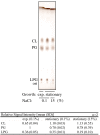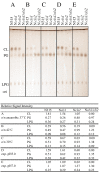Staphylococcus aureus requires cardiolipin for survival under conditions of high salinity
- PMID: 21241511
- PMCID: PMC3030509
- DOI: 10.1186/1471-2180-11-13
Staphylococcus aureus requires cardiolipin for survival under conditions of high salinity
Abstract
Background: The ability of staphylococci to grow in a wide range of salt concentrations is well documented. In this study, we aimed to clarify the role of cardiolipin (CL) in the adaptation of Staphylococcus aureus to high salinity.
Results: Using an improved extraction method, the analysis of phospholipid composition suggested that CL levels increased slightly toward stationary phase, but that this was not induced by high salinity. Deletion of the two CL synthase genes, SA1155 (cls1) and SA1891 (cls2), abolished CL synthesis. The cls2 gene encoded the dominant CL synthase. In a cls2 deletion mutant, Cls1 functioned under stress conditions, including high salinity. Using these mutants, CL was shown to be unnecessary for growth in either basal or high-salt conditions, but it was critical for prolonged survival in high-salt conditions and for generation of the L-form.
Conclusions: CL is not essential for S. aureus growth under conditions of high salinity, but is necessary for survival under prolonged high-salt stress and for the generation of L-form variants.
Figures









Similar articles
-
Characterization of Staphylococcus aureus cardiolipin synthases 1 and 2 and their contribution to accumulation of cardiolipin in stationary phase and within phagocytes.J Bacteriol. 2011 Aug;193(16):4134-42. doi: 10.1128/JB.00288-11. Epub 2011 Jun 10. J Bacteriol. 2011. PMID: 21665977 Free PMC article.
-
Alternative cardiolipin synthase Cls1 compensates for stalled Cls2 function in Staphylococcus aureus under conditions of acute acid stress.FEMS Microbiol Lett. 2013 Jan;338(2):141-6. doi: 10.1111/1574-6968.12037. Epub 2012 Nov 22. FEMS Microbiol Lett. 2013. PMID: 23106435
-
Two Distinct Cardiolipin Synthases Operate in Agrobacterium tumefaciens.PLoS One. 2016 Jul 29;11(7):e0160373. doi: 10.1371/journal.pone.0160373. eCollection 2016. PLoS One. 2016. PMID: 27472399 Free PMC article.
-
Cardiolipin synthase from yeast.Biochim Biophys Acta. 1997 Sep 4;1348(1-2):201-6. doi: 10.1016/s0005-2760(97)00117-3. Biochim Biophys Acta. 1997. PMID: 9370334 Review.
-
Cardiolipin at the heart of stress response across kingdoms.Plant Signal Behav. 2014;9(9):e29228. doi: 10.4161/psb.29228. Plant Signal Behav. 2014. PMID: 25763690 Free PMC article. Review.
Cited by
-
Vertical physico-chemical gradients with distinct microbial communities in the hypersaline and heliothermal Lake Ursu (Sovata, Romania).Extremophiles. 2014 May;18(3):501-14. doi: 10.1007/s00792-014-0633-1. Epub 2014 Feb 15. Extremophiles. 2014. PMID: 24531691
-
Exploring the existence of lipid rafts in bacteria.Microbiol Mol Biol Rev. 2015 Mar;79(1):81-100. doi: 10.1128/MMBR.00036-14. Microbiol Mol Biol Rev. 2015. PMID: 25652542 Free PMC article.
-
Phosphatidylglycerol homeostasis in glycerol-phosphate auxotrophs of Staphylococcus aureus.BMC Microbiol. 2013 Nov 16;13:260. doi: 10.1186/1471-2180-13-260. BMC Microbiol. 2013. PMID: 24238430 Free PMC article.
-
The first genomic characterization of a stable, hemin-dependent small colony variant strain of Staphylococcus epidermidis isolated from a prosthetic-joint infection.Front Microbiol. 2023 Oct 19;14:1289844. doi: 10.3389/fmicb.2023.1289844. eCollection 2023. Front Microbiol. 2023. PMID: 37928677 Free PMC article.
-
Genomic insights into the virulence and salt tolerance of Staphylococcus equorum.Sci Rep. 2017 Jul 14;7(1):5383. doi: 10.1038/s41598-017-05918-5. Sci Rep. 2017. PMID: 28710456 Free PMC article.
References
Publication types
MeSH terms
Substances
LinkOut - more resources
Full Text Sources
Other Literature Sources
Molecular Biology Databases

